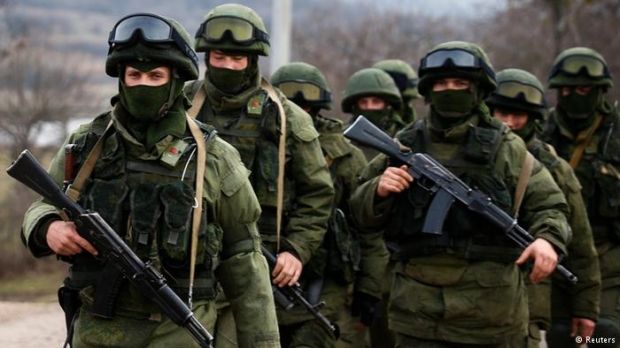
Under the Russian Federation, the term maskirovka has evolved from tactical camouflage in military operations to a broader set of means of denial and deception on a strategic level – including political, economic and diplomatic measures to achieve international goals, Havrylov told the Cipher Brief.
Russia has inherited these Soviet methods and has actively used them in conflicts with former-Soviet states. This has stretched from the 1990s and continues to the present day: including in the North Caucus (Chechnya 1994-1996), Moldova (Transnistria 1992) and Georgia (Abkhazia 1992-1993, South Ossetia 2008).
Read alsoPutin's statement direct blackmail to U.S., war threat to Kyiv – MPCurrent Russian leadership understands the use of traditional methods of maskirovka in achieving foreign policy goals is quite a delicate mission, which requires more sophisticated and stealthy technologies. “Russian President Vladimir Putin does not want Russia to be isolated. He personally wants to be a part of the world elite and is interested in building up a positive image and reputation for Russia in the international arena,” according to the Ukrainian diplomat.
Publicly, Moscow has to demonstrate its commitment to international rules and laws, and avoid open interference in the internal affairs of other states. Consequently, the principal goal of maskirovka in modern Russia’s foreign policy strategy is to hide Moscow’s involvement in destabilizing efforts in other countries, Havrylov believes.
“We are not there” was a typical Moscow response to accusations of its participation in events in Crimea in 2014 and eastern Ukraine in 2014-2017.
But when Russia can no longer hide its involvement, it offers a “civilized” justification of its actions by referring to the protection of human rights and other pseudo-democratic phraseology.
In trying to hide the presence of its troops in Ukraine and to prevent other countries from providing assistance to Kyiv, Russia used traditional tactics of obfuscation known as the “4D” approach:
Read alsoRussia trying to influence Dutch public opinion on MH17 with fake news - minister Dismiss – as Putin did for over a month despite it being obvious that Russian soldiers had occupied Crimea
Distort – as exemplified by an actress playing the role of a pro-Russian Ukrainian
Distract – as Russian media did with absurd theories about the downing of Malaysian Airlines Flight MH17
Dismay – as Russia threatened to deploy nuclear-capable bombers to Crimea
The main methods of disguise and concealment of Russian activities in Crimea and East Ukraine in 2014-2017 include soldiers with no insignia on their uniforms; use of volunteers from Russian nongovernmental ultra-nationalist organizations; hidden transfer of weapons and munitions from Russian territory; use of humanitarian convoys for supplying ammunition and fuel to East Ukraine; and information warfare (disinformation and propaganda).
Putin’s decision to deploy Russian military forces to Ukraine was a desperate move when alternative methods had already failed. The presence of a regular military force was difficult and virtually impossible to hide, which is one of the weaknesses of Russian military doctrine of maskirovka when applied in peacetime.
Read alsoRussia attacked energy, telecom and media in Britain: gov't officialThere were other miscalculations that contributed to the failure of Putin’s hybrid strategy and deception in Ukraine: lack of pro-Russian sentiment in eastern and southern Ukraine; a mature civil society in Ukraine; an active young generation of Ukrainians with memories of repression under Joseph Stalin and the Holodomor, or famine, he imposed; the effect of the global internet as a source of information; Russian military prisoners in Ukraine; and unexpected and unpredictable events, known as black swans, such as the downing of Flight MH17 by a Russian missile, the dramatic fall of oil prices and international sanctions against Russia.
Russian tactics of maskirovka have also been unmasked over the internet as photos and videos of Russian military presence in Crimea and eastern Ukraine have been immediately posted on social networks, frequently even by Russian soldiers themselves in order to impress their friends and relatives. This phenomenon had not yet been taken into account by Russian military masterminds.
Russia also did not succeed in hiding the heavy casualties it suffered in Ukraine.
It turned out that the application of the doctrine of maskirovka in the modern international environment may have given Russia a temporary tactical advantage but created substantial strategic problems. That includes a loss of trust, isolation, international sanctions, and the resulting economic decline and degradation of Russia’s society.
Read alsoEight EU member states urge Mogherini to take tougher steps to counter Russian propagandaUkraine has learned that the best way to prevent and preempt the success of Russian use of maskirovka is to collect and disseminate, in real-time, facts and evidence of Russian hybrid and illegal activities on foreign territories through use of modern information technologies. This strategy may also apply to Moscow’s interference in the internal affairs and politics of Western countries.
“Truth and transparency frighten Moscow. They pose a direct threat to Russian internal and foreign policy that is based on half-truth, manipulation of public opinion and disinformation,” the Ukrainian diplomat concludes.

